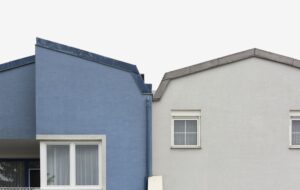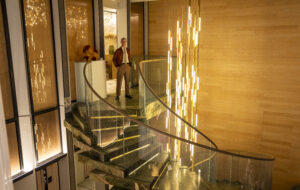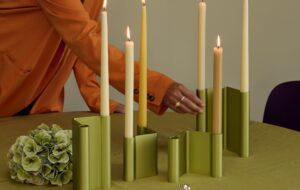

![]()
Trash Lux
100% Design
Gradual
Tent London
Fuse
Designersblock
Designersblock Illustrate
Gallery Libby Sellers
Royal Festival Hall
Mint
This year, the London Design Festival felt like a festival
The event gets bigger every year, but this time there was a sense that people were starting to work together rather than just setting out their own stalls. Coinciding exactly with London Fashion Week and using the newly reopened Royal Festival Hall on the South Bank as a central hub, the festival seemed to grow in significance. It remains a diverse and sprawling thing, but fringe events have started coalescing into clusters, making it all feel a bit more coherent.
In the west of the capital this took the form of the newly packaged Brompton Design District, bringing together gallery and studio shows in the museum-land of South Kensington. Meanwhile, the East End had a new anchor show in Tent London, which took over the Truman Brewery on Brick Lane and, along with Designersblock, added ballast to proceedings in the area.
There was a theatrical feel here and there. Some of Martino Gamper’s Royal College of Art graduates were making work in front of people and holding what felt like a student sit-in in a stripped Kensington mansion house. At the same time there was a “fight club” for artists going on at Designersblock Illustrate on the Holloway Road, north London.
Events like these lived up to London’s less formal, more experimental reputation. It’s interesting that so much of the festival focuses on objects, given that the city trades more heavily in design services such as graphics and branding. Unable to match Milan in manufacturing and design wheeler-dealing, London serves as an international talent pool. Most of the work is by designer-makers, and that can sometimes create a studenty feel, but that’s only natural in a city that trades in ideas.
Early reports suggest that the week’s umbrella body, London Design Festival, was doing a better job this year. Criticisms persist – chiefly that it still charges participants £295 to be in the “official” guide and so is making life harder for designers rather than easier – but there was recognition that the LDF was supporting and promoting shows across the board rather than focusing special attention on their own events.
By rights, London ought to have one of the liveliest, most distinctive design weeks in the world. And it does. But since it can’t compete with Milan, the question is how it defines itself. If experimental, limited-edition and student work is what we do best, then that’s what we should present to the world. Because if there’s one thing the city does well, it’s making reputations.
It wouldn’t be the London Design Festival without Stuart Haygarth stealing the show. Made out of spectacle lenses, Haygarth’s Optical chandelier (see top) reflected and refracted light in a way that made the air appear to melt. It was exhibited as part of Trash Luxe, an exhibition at department store Liberty curated by design journalist Marcus Fairs. The show gathered work by designers renowned for making beautiful objects out of items we might consider disposable. Among our other favourites were Karen Ryan’s Custom Made table (below), which is assembled from bits of other tables and repainted in a Mondrian-style grid, and Max Lamb’s Poly furniture (bottom), which is made out of polystyrene that he shaped with a claw hammer and then coated in rubber.
Of the week’s events, Fairs says: “The London Design Festival was better than last year. It was more focused. But the week still doesn’t know quite what its audience is. The city needs to think about what it’s offering. You can’t expect designers to show new work in Milan and London. Maybe London is the city where people make sense of what they’ve seen in Milan. You want an edit.”


The best thing we saw at 100% Design was this £1 drawing pin (below). Designed by Japanese design company 100per, the head has a magnetic pull strong enough to hold a stapler.
Martino Gamper’s graduates were given free run of a marble-floored mansion in Kensington and told they could do anything they wanted to it. They dribbled blue paint on the walls, engraved their names into floorboards and windowsills, made pieces of furniture in front of spectators and installed a huge swing. The idea was to show processes and ideas rather than polished pieces. Our favourites were Oscar Diaz’s calendar (below), which sucks up ink to colour in numbers day by day, and Shay Alkalay’s giant tower of drawers (top left). There were also two two-metre long loaves of bread (bottom).


Martino Gamper
The designer and organiser of Gradual thinks London needs to get away from the idea of finished products:“Milan is about products, London is more about creativity and ideas. London shows a more cultural side to design, rather than saying design should be functional. It doesn’t have the baggage Milan has – you’re freer to move.
London has to use what it’s got – which isn’t a manufacturing base. A lot of people produce things themselves, or things are made for small production. There should be more space to show this cultural, experimental side. But the London Design Festival also has to open up to a market that isn’t just about mass production. It should focus on a certain quality. It should be about ideas rather than products.
Young designers need time to explore – but the media brands the young too soon. One of the problems of the festival is that everyone wants finished pieces. My show was about giving graduates time to experiment and evolve. Their first year out of college is very intensive and fast. They need time to learn what the industry is all about, and where they want to be in it.
My show was to give designers a chance to do this. It was so they could find out more about themselves, and to do some work, rather than show the same thing over and over again.”
Set up by 100% Design founder Ian Rudge and 100% East founder Jimmy MacDonald, Tent London brought the two events together in the Truman Brewery to dominate east London. Under the Tent umbrella was a hall reminiscent of Milan’s Superstudio called Superbrands, an area selling vintage furniture, and Content and Talent Zone, which showed mainly recent graduates, young designers and up-and-coming names.
The aim was to attract new visitors to the area, and appeal to consumers as well as manufacturers. Among our favourite ideas was Kieren Jones’ You-Can-Do-It bookcase (below). The young designer cheekily exploited a service offered by DIY stores by composing an instruction leaflet that shows store workers how to bind together planks you’ve bought to create shelving. Bethan Wood designed some ceramic teacups with an unglazed pattern (below) that emerges gradually as the tea stains build up.
From Farm Designs, a renegade collective originating from Loughborough University’s design course, we particularly liked Guy Brown’s Siamese Chair (below) – an original take on a very familiar plastic classic with a seductively shiny fibreglass seat. Over in the Talent Zone, the best work we saw was Ravensbourne graduates’ Rare Breeds exhibition. Presented on huge stacks of hay, it was good to see the group’s work outside the New Designers environment looking just as strong and professional. Mary Argyrou’s Unspoken Feelings clocks (below) vary a minimal clockface to respond to differing emotional states – Sad Time, for instance, distributes tissues. George Pegasiou’s Prop 01 chair (below) has a built-in walking stick, which is useful but also plays on the different connotations of bentwood forms, and Yuta Watanabe made a variety of small-scale pieces that play with stationery – the Peg Pencil (below) and the All Corners eraser (below) are particularly beguiling.
Japan-based studio WOW, who will be moving to London next year, stole the show with its hypnotic video installations. Beautiful and confusing, Tengible (below) looked like a shadow play behind a screen but wasn’t.
Majid Asif’s stackable Phantom chair (below) was part of an outstanding showing by the Fuse Collective at Partridge Fine Art. It’s stamped from a single sheet of steel and could be a stealth fighter cousin of Verner Panton’s eponymous chair, echoing the Panton’s curves in sharp folds. Partridge Fine Art was an interesting choice of venue for Fuse – it’s more accustomed to Beaux Arts furniture than contemporary design. Perhaps 2008 will be the year that antiques dealers move strongly into new design.

Ian Rudge
The 100% Design and Tent London co-founder talks about the virtues of heading east:
“When I started 100% Design there was no design event at all – all design was specified. I wanted to make it all accessible. In the last four or five years there’s been a growing interest from consumers. I want to make Tent London a place for the public. It’s more informal and it’s marketed more to consumers than trade people.
Designers are aware of the east but we’re trying to get the rest of the world to realise it’s a destination. There are more surprises being here – it’s a much livelier place. Suddenly there’ll be a great big fashion party on the roof next door. At Earl’s Court there’s no passing business – you go there to see a particular show. The spaces here are half the price of conventional venues. Also, in an industrial venue like the brewery the practical aspect of putting on an exhibition is much harder. There are so many challenges to overcome.
The festival is maturing – it means we can promote London and we’re all competing but working towards the same goal. London should have the biggest design event in the world.”
Kieren Jones
Young London-based designer Kieren Jones offers an alternative perspective on the week’s proceedings:
“I think the London Design Festival has gone quite corporate, especially 100% Design. There aren’t as many open studios or little shows curated by a couple of young designers. The only way a young designer or recent graduate can exhibit is in a corporate environment. You show here [in Tent] because it’s the place to be shown. You have to be in this environment or not at all.”
Over at Designersblock’s tenth London anniversary show there was a lively atmosphere. This year, the aim was to show design in a wider context so there was a mix of stalls from manufacturers and young designers in the hope of creating a breeding ground for new relationships. We particularly liked Karen Ryan’s expressionist lampshades (below) and Tamsin van Essen’s collection of apothecary jars which mimic diseases (pictured here are sufferers of psoriasis and osteoporosis) (below). Best of all though were the glass blowers that melted new forms out of the abundance of empty beer bottles the party threw up (below).
Designersblock’s new Illustrate show presented work from more than 80 illustrators, artists, designers and film-makers, and sprawled over 40 commercial units in Holloway. Visitors could doodle on milking stools and colour in an illustration by artist Jon Burgerman – making a nice change to shows where you can’t even sit on the furniture. There was also a live illustration competition, Secret Wars (below), which was described by Rory Dodd as “a fight club with pens”. It all made for great entertainment.
play video of Designersblock Illustrate
Octave (below) by Peter Marigold was one of the highlights at Gallery Libby Sellers in South Kensington. The piece consists of seven unique free-standing shelving units, each supported by a single branch split lengthways into four. The project was inspired by the affinities between natural forms and musical instruments, hence the name, and to reinforce the link each shelf has a circular hole cut into it, surrounded by the same marquetry as guitar soundholes. This show was the debut for Libby Sellers’ new gallery, and also on display were works by Stuart Haygarth, Julia Lohmann and Moritz Waldemeyer.
A new hub of events on the South Bank provided a contrast to the Truman Brewery’s grit, stench and cobbles. Events included an installation by Zaha Hadid, Super Design Market, where people could buy pieces by rising stars and big names for £5-£100, and Swarovski’s Crystal Palace exhibition. A nice idea was the Deptford Design Challenge, in which designers picked an object from Deptford market to make into something beautiful. Most of the results needed some work, but we liked Gitta Gschwendtner’s chandelier of flying shuttlecocks (below).

Mint
Maxim Velcovsky’s new Catastrophe range (below) of vases was on display at Wigmore Street design shop Mint. The dirt-encrusted vases look like they have just been pulled out of a bomb crater, and have inclusions such as keys, twigs and bits of broken china fused into their rough forms. They’re instant archaeology, pieces that seem to come equipped with a story. It’s a stark change from the simplicity, honesty and beauty of Velcovsky’s earlier work. But they did make an interesting contrast to his 2006 Melted Beauty range, also on display, and Emma Passey’s milky, liquefying A Lovely Cup of Tea teaset.

Thorsten Van Elten
A stalwart supporter of young local designers, the London retailer will be closing his Warren Street shop in January. Here he explains why:
“For some reason not enough people are coming into the shop and the rent is outrageous. It just doesn’t make sense any more. I love the shop, and I love the people coming here, people appreciating design – not just the design enthusiasts, but the general public who stumble upon it and appreciate good design. Unfortunately there’s a lot of hypocrisy about it – people come in and say, ‘Oh, what a lovely shop,’ but they walk out without buying anything and later you see them with Habitat bags. The website will still be trading, and I am looking for an alternative shop.
One thing about the London Design Festival that I have a big problem with is the fee charged for being in the booklet – nearly £300. With the amount of funding they’re receiving, it’s wrong that the people who actually make it happen are the ones who have to pay for it.
And I thought the festival was lacking direction. For me it was too art-based, it was just installation after installation. The honesty of it wasn’t there any more – it’s becoming too elitist, and I think we need to include everybody again. We need to start designing for the masses, rather than going up this art road where people just say, ‘What was that about?’ and the prices are just ridiculous.”































